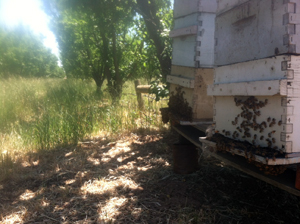
There’s been a lot of press lately on the serious decline of the honeybee population known as CCD (colony collapse disorder) and its link to the insecticide class known as neonicotinoids. The EU voted in a two-year ban on the pesticides this week and there has been a lot of pressure for the US to follow suit.
The collapse of our pollinators is serious business. The United Nations Environmental Program reports that of the 100 crop species that supply 90 percent of the world food supply, 70 percent are dependent on the pollination services of bees. Scientists from around the world are looking for answers to this very real problem in agriculture and to our food security.
Neonicotoides, are a nicotine derived systemic pesticide. The pesticide is often embedded into the seed itself so that as the plant grows, it carries the pesticide with it. Many pesticides degrade fairly quickly after application (a few days) but neonicotoides can persist for months within a plant, and kill insects that feed upon it. The theory is that bees carry pesticide laden pollen back to the hive, which endangers the foodstuff of living and future generations of bees.
It is no wonder people are concerned with the effects of neonicotoides on honeybee colony health. Over the last year, I’ve spoken with Alan Hawkins on the subject numerous times. Alan has been keeping bees organically for over 30 years and is well versed in the art of beekeeping. Alan’s opinion on the subject of neonicotoides is that banning the use of neonics will not be a silver bullet. He feels that causes of CCD are complex, multifaceted, and interrelated. The industrial agriculture model, and all the components that are required to keep it running, play into the problem. Monoculture, the literal soup of pesticides required to support them, the loss of habitat for pollinators and other beneficial insects that ensues, beekeeping practices that require hives to travel long distances on transfer trailer trucks every year to provide pollination services stress hives, parasites in the hives that are treated with more insecticides, and on.
Many beekeepers and apiculturists mirror Alan’s opinion on the subject of CCD. Eric Mussen, an apiculturist at U. C. Davis, documented about 150 chemical residues in pollen and wax gathered from beehives. He questions what the effect of this soup of chemicals interacting may be. In isolation the chemicals are at sub-lethal levels, but no one really knows how they react with one another when combined.
The EPA released a study that concluded that it is unclear if a certain class of pesticides is the main culprit in CCD, but points to a parasitic mite found in hives known as Varroa as “the single most detrimental pest of honeybees”. EPA researchers state “It is not clear, based on current research associated with US honeybee health declines in general or specifically affects the production of honey or delivery of pollination services”. The EPA study does indicate that honeybee populations can be seriously harmed by the exposure to high doses of insecticidal compounds.
This writer and organic food advocate is as far from a scientist as anyone could be, but agrees with Alan that CCD is a reflection of the very broken system of the industrial agriculture model.

 Follow
Follow
